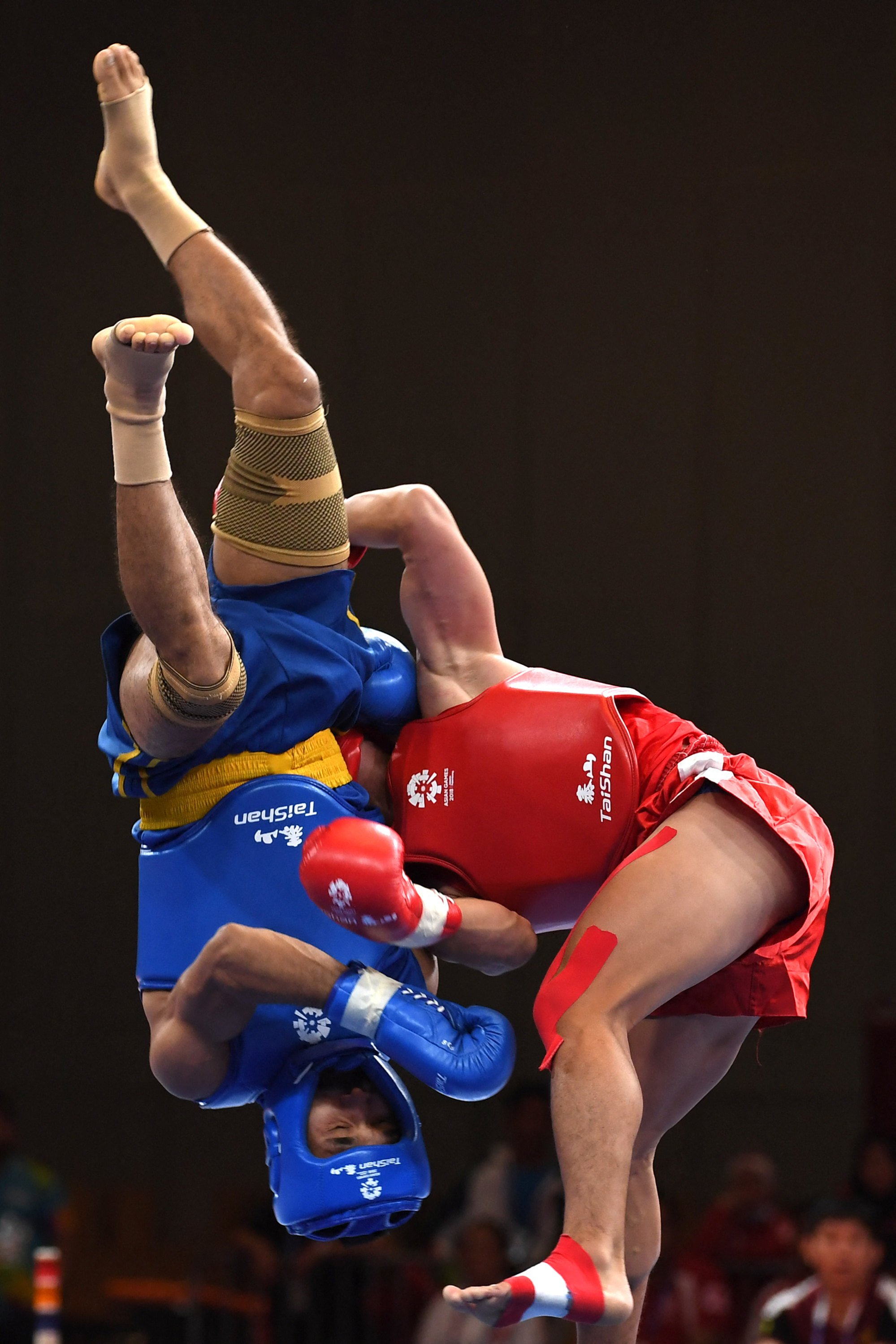
CHINESE SANDA VS KOREAN TAEKWONDO: ASIAN MARTIAL ARTS BOTH BUILT ON ANCIENT STYLES
- Both relatively young martial arts also emphasise the importance of respect and honour, but their techniques are quite different
From ancient Shaolin techniques to iconic movie stars like Bruce Lee, delve into the history, philosophy and cinematic impact of kung fu with our martial arts series.
Asian martial arts are as diverse and varied as the region itself, from Shaolin kung fu (China) and judo (Japan) to taekwondo (Korea) and Muay Thai (Thailand), to name but a few.
While these all involve different styles of fighting and self-defence, they share one thing in common: all are deeply rooted in traditions and have evolved and improved over many decades.
Do you have questions about the biggest topics and trends from around the world? Get the answers with SCMP Knowledge, our new platform of curated content with explainers, FAQs, analyses and infographics brought to you by our award-winning team.
Here, we look at the similarities and differences between Chinese sanda and Korean taekwondo, including the techniques involved and how both stem from their country's martial arts traditions.
With the exciting recent news that 22-year-old Lo Wai-fung will make history by becoming the first taekwondo athlete from Hong Kong to compete in the Olympics, in Paris this year, it is an opportune time to learn more about these two martial arts forms.
Sanda
Sanda is a Chinese self-defence system and combat sport. Created in 1979 by the Chinese government's General Administration of Sport, it is a relatively young fighting system that is based on both traditional Chinese martial arts and modern combat techniques.
According to a 2019 interview with Qian Renbiao, a pioneer of sanda and the first head coach of China's national sanda team, the combat system was created to enhance the performance of Chinese martial arts when pitted against non-Chinese fighting systems.
The General Administration of Sport, a government agency that oversees sport development on the mainland, invited famous wushu masters from all around the country to a national convention in Beijing in 1979. Masters of the wide-ranging Chinese martial arts spectrum - including chang quan, tai chi and mian quan - all gathered.
"A unified set of rules were to be set," Qian said. "They decided to mix the Chinese techniques with non-Chinese techniques, and the old techniques with the new. That became sanda."
A lot of the upper body movements such as punches and throwing came from boxing and shuai jiao, which is a form of Chinese wrestling. A lot of the kicks were adopted from wushu, taekwondo, karate and Muay Thai.
While martial arts can be broadly divided into those that focus on kicking and punching (taekwondo and karate, for example), and those that focus on wrestling (Greco-Roman wrestling, jujitsu, judo), sanda is a hybrid of the two styles.
"Sanda is a combination of Chinese and foreign elements," Qian said. "It is definitely not the purest form of traditional martial arts, but it has elements of tradition."
Fighters with a background in sanda have been successful in the UFC. Zhang Weili, the current and two-time UFC Women's Strawweight Champion, from China's Hebei province, has a sanda background.
However, the mixing and matching of techniques from different martial arts earned sanda the nickname "gangster style" in Hong Kong.
Hong Kong sanda champion Sunny Cheung Yat-Lam - who won a bronze medal at the 2023 World Wushu Championship in the US in the 70kg (154lb) category, and another at the 2024 International Wushu Invitational Tournament in China - says that such a comparison is very wrong.
He says just like other wushu traditions, sanda emphasises the importance of respect, balancing both martial and literary virtues, and cultivating inner as well as outer strength.
The signature hand gesture of sanda that athletes use to salute their competitors and coaches before a match is a clear example of this, he adds.
"Sanda includes wu de [martial morality]. Like we have left and right hands, we need to have wen [literacy] and wu [martial]. We need to remember the scholar's manners," he says.
What does Cheung think of the similarities sanda shares with other martial arts?
"Sanda is similar to other combat sports, like taekwondo - they are both speedy in the legs. Some tactics in sanda can be used in taekwondo.
"If we take away the difference between Muay Thai and sanda in terms of the knees and elbows action, they're also quite similar."
Taekwondo
Taekwondo is Korea's most famous martial art. Based on the number of countries and dojang (studios) registered with the taekwondo administering body in South Korea, it is estimated that there are more than 200 million people who learn and practise the martial art. The figure speaks of its wide appeal to the general public.
It may come as a surprise, then, that taekwondo is also a new addition to Korea's long history of martial arts, similar to sanda in China. Much lesser known are taekkyon and subak, two martial arts that date back to Korea's ancient times.
Subak can be traced to the Three Kingdoms period in the Korean peninsula, which lasted from circa AD57 to AD668. The name is believed to have come from the Korean word for "clap" and aptly represents the martial art's heavy use of the hands.
Taekkyon, meanwhile, is first mentioned in early 18th-century texts and is characterised by its dance-like basic footsteps.
Taekwondo was only consolidated in the 1950s. While the creation of sanda can be clearly traced back to the national convention held in 1979, the story of how taekwondo came to be is still being contested, as well as how much of it originated from the country's traditional martial arts.
One version goes that during the Japanese occupation of Korea (1910-45), the colonial government banned Koreans from practising any kind of martial arts, fearing that people would use them to rebel.
After the Korean peninsula was decolonised in 1945, nine major martial arts schools were set up in the country. The masters of these martial arts schools later came together to systematise what became taekwondo.
The name was coined in 1959, when one of the pioneers published the first textbook of the martial art. But the name was not widely accepted and at first the new system was referred to by many monikers, including taesoodo and gongsoodo. The name "taekwondo" was only affirmed in 1961 when the Korea Taekwondo Association was established.
In the 1970s, the Korean government started to promote taekwondo internationally as the country's main form of martial arts.
However, many of the martial arts masters who created taekwondo had previously trained in other Asian martial arts traditions, such as wushu and Japanese karate.
This, and the fact that some taekwondo movements share similarities with wushu and karate, has led some to say that taekwondo adopted a lot of its elements from its neighbours' martial arts.
While there may be some truth to this, Master No Rae - a taekwondo master who runs four studios in Hong Kong and who prides himself in spreading taekwondo outside Korea - says there are many elements of taekwondo that can be traced back to Korea's traditional martial arts of taekkyon and subak.
"Taekwondo adopted a lot of the hand techniques from subak and foot techniques from taekkyon," No says.
It is possible to spend hours analysing the origin of taekwondo, but for most people it does not matter.
Since its inception, taekwondo has evolved in unique ways. Now, it is recognised around the world as a separate and respected martial art form from Korea. In 2000, it became an Olympic sport category.
Taekwondo has three main disciplines: kyorugi, poomsae and kyukpa. Kyorugi is sparring; poomsae is the showcasing of attack and defence techniques; and kyukpa, which means "smashing" in Korean, sees athletes demolish wooden boards, often many at the same time, with seemingly impossible kicks and punches.
The highlight of taekwondo is definitely the spectacular kicks that are a mix of power and speed. There are many kinds of kicks, such as high kicks, jumping and spinning kicks, and rapid multiple-kick combinations.
"Martial arts such as kickboxing and Muay Thai have kick techniques that strike with one blow," No says. "So when kicking ... the kicks are delivered strongly without folding the knee.
"But in taekwondo, there are many more dynamic kicks that allow you to kick, fold your knee and then do a variety of kicks from there.
"So, rather than just stopping after delivering your kick, you can do several more moves - back and forth, left and right. Then you can do them all quickly. That's the special charm of taekwondo."
Another element that makes taekwondo special - and which bears a similarity to sanda - is the importance of the traditional Korean cultural elements of respect and honour.
The emphasis taekwondo places on these values is immediately evident, even from its name, No says. While the first two words, "tae" and "kwon", refer to striking with foot and hand, respectively, "do" refers to the "rules of etiquette that must be cultivated as a human being", he says.
"So in our case, when we teach taekwondo, we not only teach these skills, but we also provide guidance on how to overcome hardships, how to learn manners, and how to respect each other as well as your parents, teachers and seniors."
More Articles from SCMP
Tesla eligibility for Chinese state purchases could clear way for self-driving approval
Qualification requirements for Hong Kong dentists ‘not arbitrarily imposed’, council says
Hong Kong’s San Tin Technopole needs more private flats to draw talent, developers say
Meet Prince Constantine-Alexios of Greece, who’s dating model Brooks Nader
This article originally appeared on the South China Morning Post (www.scmp.com), the leading news media reporting on China and Asia.
Copyright (c) 2024. South China Morning Post Publishers Ltd. All rights reserved.
2024-07-04T20:40:21Z dg43tfdfdgfd
